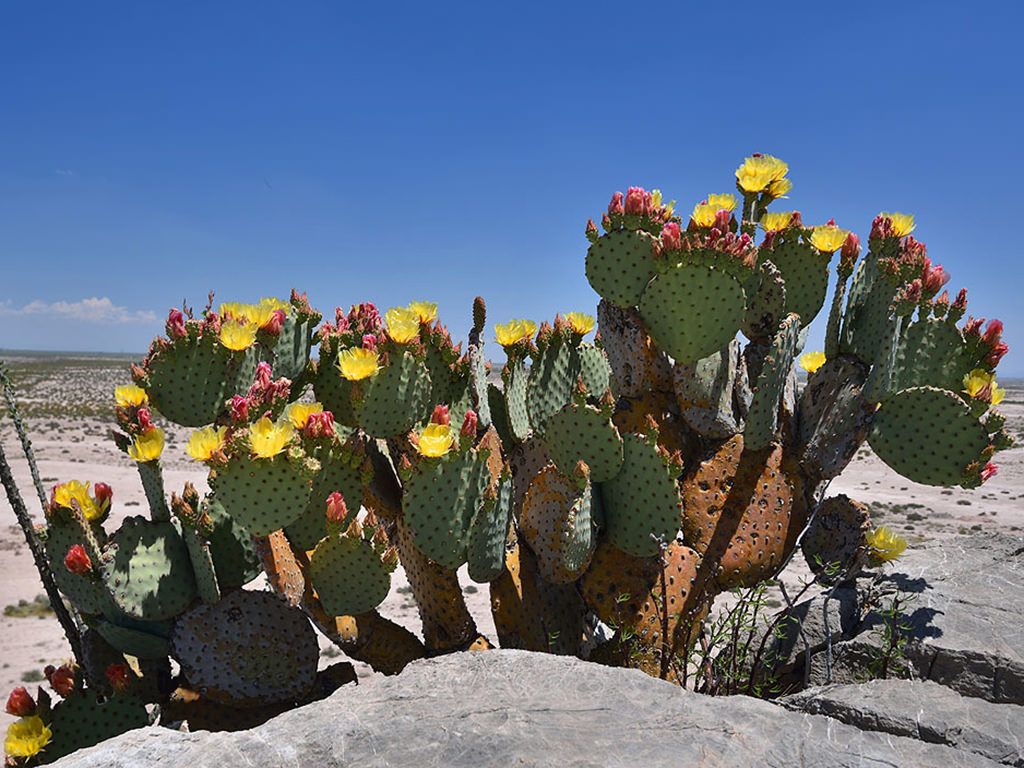Scientific Name
Opuntia rufida Engelm.
Common Name(s)
Blind Pear, Blind Prickly Pear, Cinnamon Cactus, Cinnamon Bunny Ears, Cinnamon Pear, Clock Face Cactus, Cow Blinder, Red Bunny Ears
Synonym(s)
Opuntia henfeldtii, Opuntia herrfeldtii, Opuntia lubrica, Opuntia microdasys subsp. rufida, Opuntia microdasys var. rufida, Opuntia rufida var. tortiflora
Scientific Classification
Family: Cactaceae
Subfamily: Opuntioideae
Tribe: Opuntieae
Genus: Opuntia
Description
Opuntia rufida, formerly known as Opuntia microdasys subsp. rufida, is a many-branched cactus with a short trunk and stems jointed into thick, fleshy, grayish-green pads with numerous reddish-brown glochids densely arrayed at areoles. It grows up to 5 feet (1.5 m) tall. The stem segments are circular, elliptic, or obovate. They are up to 10 inches (25 cm) long and nearly equal in width. The glochids become gray with age. Spines are absent.
Flowers are yellow, changing to apricot or red with age, up to 4 inches (10 cm) long, nearly equal in diameter, and appear in spring. Fruits are obovate, red with green pulp, up to 1.4 inches (3.5 cm) long, and up to 0.9 inches (2.3 cm) in diameter.
This species is often confused with Opuntia microdasys.
Origin
Opuntia rufida is native to the Big Bend area of southwestern Texas, United States, and the Chihuahuan Desert of northern Mexico.
Etymology
The specific epithet "rufida (ROO-fee-duh)" means "becoming red" and refers to the reddish-brown glochids.
The common name "Blind Prickly Pear" refers to the tendency for the glochids to shed into the eyes of grazing cattle that bump against the plant.

Hardiness
USDA hardiness zones 9a to 11b: from 20 °F (−6.7 °C) to 50 °F (+10 °C).
How to Grow and Care
A spot near a south-facing, unobstructed window will most likely meet Bunny Ears Cactus' need for bright, direct sun. Windows with western or eastern exposure run as the second and third choices. While an actively growing Bunny Ears Cactus tolerates indoor summer temperatures as high as 100 °F (38 °C), don't expect it to flower unless you also provide winter temperatures between 45 and 55 °F (7 and 13 °C). Regardless of the season, it likes humidity in the 10 to 30 percent range. Finally, if none of your windows provides adequate light, place the plant 6 to 12 inches (15 to 30 cm) below a cool white fluorescent tube for 14 to 16 hours each day.
The potting soil must drain quickly. Use a commercial cactus potting mix or mix your own. The best container for your cactus is a clay pot, slightly larger and deeper than the plant's root system. It must have drainage holes because a pot without them or a pot that's too large could make proper watering impossible.
Learn more at How to Grow and Care for Opuntia.
Links
- Back to genus Opuntia
- Succupedia: Browse succulents by Scientific Name, Common Name, Genus, Family, USDA Hardiness Zone, Origin, or cacti by Genus
Photo Gallery
Click on a photo to see a larger version.



